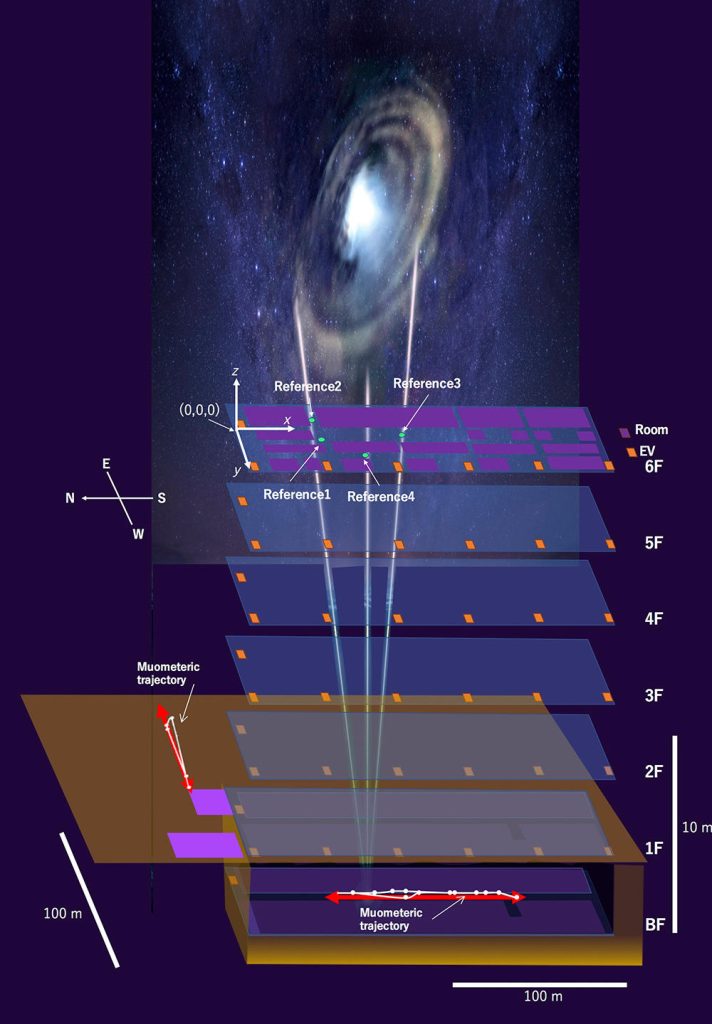
The red line in this image represents the path the “navigatee” walked, while the white line with dots shows the path recorded by MuWNS. Credit: 2023 Hiroyuki K.M. Tanaka
Innovative technology allows for navigation in areas where GPS can’t reach.
In a reported global first, researchers from the University of Tokyo have used superfast, subatomic particles known as muons to wirelessly navigate underground. The team utilized ground stations that detect muons, coordinating them with a subterranean muon-detecting receiver to pinpoint the receiver’s location in the basement of a six-story building.
Since GPS is ineffective through rock and water, this emerging technology holds promise for future applications such as search and rescue missions, monitoring underwater volcanoes, and directing autonomous vehicles in subterranean and aquatic environments.
GPS, the global positioning system, is a well-established navigation tool and offers an extensive list of positive applications, from safer air travel to real-time location mapping. However, it has some limitations. GPS signals are weaker at higher latitudes and can be jammed or spoofed (where a counterfeit signal replaces an authentic one). Signals can also be reflected off surfaces like walls, interfered with by trees, and can’t pass through buildings, rocks, or water.
Muons exist for only 2.2 microseconds (one microsecond is just one-millionth of a second), but because they travel at the speed of light in a vacuum (300,000 kilometers per second), they have enough time to reach Earth from the atmosphere and penetrate deep into the ground. Credit: 2015 Hiroyuki K.M. Tanaka
By comparison, muons have been making headlines in recent years for their ability to help us look deep inside volcanoes, peek through pyramids, and see inside cyclones. Muons fall constantly and frequently around the world (about 10,000 per square meter per minute) and can’t be tampered with.
“Cosmic-ray muons fall equally across the Earth and always travel at the same speed regardless of what matter they traverse, penetrating even kilometers of rock,” explained Professor Hiroyuki Tanaka from Muographix at the University of Tokyo. “Now, by using muons, we have developed a new kind of GPS, which we have called the muometric positioning system (muPS), which works underground, indoors, and underwater.”
MuPS was initially created to help detect seafloor changes caused by underwater volcanoes or tectonic movement. It uses four muon-detecting reference stations aboveground to provide coordinates for a muon-detecting receiver underground. Early iterations of this technology required the receiver to be connected to a ground station by a wire, greatly restricting movement. However, this latest research uses high-precision quartz clocks to synchronize the ground stations with the receiver. The four parameters provided by the reference stations plus the synchronized clocks used to measure the muons’ “time-of-flight” enables the receiver’s coordinates to be determined. This new system is called the muometric wireless navigation system (MuWNS).
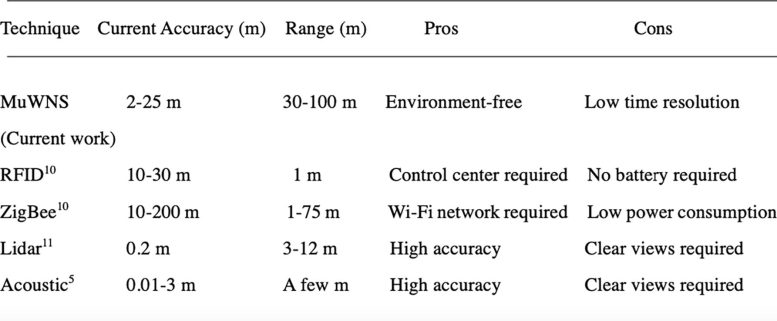
According to the researchers, when using MuWNS in an indoor or underground environment, it could achieve a higher accuracy compared to radio frequency identification (RFID) and Zigbee technologies, and a much broader range though much lower accuracy than lidar and acoustic navigation. Credit: 2023 Hiroyuki K.M. Tanaka
To test the navigation ability of MuWNS, reference detectors were placed on the sixth floor of a building while a “navigatee” took a receiver detector to the basement floor. They slowly walked up and down the corridors of the basement while holding the receiver. Rather than navigating in real time, measurements were taken and used to calculate their route and confirm the path they had taken.
“The current accuracy of MuWNS is between 2 meters and 25 meters, with a range of up to 100 meters, depending on the depth and speed of the person walking. This is as good as, if not better than, single-point GPS positioning aboveground in urban areas,” said Tanaka. “But it is still far from a practical level. People need one-meter accuracy, and the key to this is the time synchronization.”
Improving this system to enable real-time, meter-accurate navigation hinges on time and money. Ideally, the team wants to use chip-scale atomic clocks (CSAC): “CSACs are already commercially available and are two orders of magnitude better than the quartz clocks we currently use. However, they are too expensive for us to use now. But, I foresee that they will become much cheaper as the global demand for CSAC for cellphones increases,” said Tanaka.
MuWNS could someday be used to navigate robots working underwater or guide autonomous vehicles underground. Aside from the atomic clock, all the other electronic components of MuWNS can now be miniaturized, so the team hopes that eventually fitting it into hand-held devices, like your phone, will be feasible. In emergency situations like a building or mine collapse, this may be a future game changer for search and rescue teams.
Reference: “First navigation with wireless muometric navigation system (MuWNS) in indoor and underground environments” by Hiroyuki K.M. Tanaka, Giuseppe Gallo, Jon Gluyas, Osamu Kamoshida, Domenico Lo Presti, Takashi Shimizu, Sara Steigerwald, Koji. Takano, Yucheng Yang and Yusuke Yokota, 29 May 2023, iScience.
DOI: 10.1016/j.isci.2023.107000

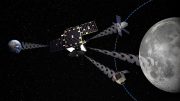


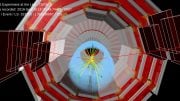

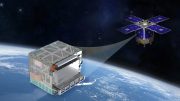


That’s really interesting and I can understand how it works post plot in determine your track. But how would it work to guide you or the robot in real time? There is no almanac of predicted muon behaviour?
You’d need a radio or wire connection with the team on the surface to maintain communications, including the time when your detector goes off. This just tells them where you are; then they can tell you. Fast cosmic ray muons pass through every palm-sized area about once a second, all the time.